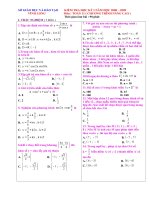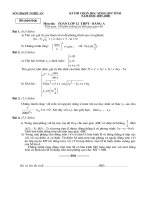A 561 08 (2014)
Bạn đang xem bản rút gọn của tài liệu. Xem và tải ngay bản đầy đủ của tài liệu tại đây (64.18 KB, 2 trang )
Designation: A561 − 08 (Reapproved 2014)
Standard Practice for
Macroetch Testing of Tool Steel Bars1
This standard is issued under the fixed designation A561; the number immediately following the designation indicates the year of
original adoption or, in the case of revision, the year of last revision. A number in parentheses indicates the year of last reapproval. A
superscript epsilon (´) indicates an editorial change since the last revision or reapproval.
This standard has been approved for use by agencies of the U.S. Department of Defense.
1. Scope
5. Sampling
1.1 This practice for macroetch testing has been found to be
a useful and reliable method for evaluating the quality of tool
steel bars. It is used as a quality control and inspection test to
reveal by deep acid etching the macrostructure in specimens
cut from bars and to show the presence of such conditions as
pipe, cracks, porosity, segregation, or foreign material. The
etched surface is generally examined visually, but magnification up to about 10× is occasionally employed.
5.1 The selection of specimens for macroetch testing must
be done with care for interpretations to be of value.
5.1.1 Specimens are usually cut from hot-rolled annealed
bars, but may be cut from machined or ground bars if the bars
are to be finish machined or ground.
5.1.2 The specimen should be located at a sufficient distance
from the end of the bar to avoid end effects.
5.1.3 For ease in handling, use specimens 1⁄4 to 1⁄2 in. (6.35
to 12.7 mm) thick.
5.1.4 Cut specimens to expose a transverse section of the
bar; however, the test is occasionally performed on a longitudinal section.
5.1.5 Specimens may be taken from one or both ends of a
bar. Each bar may be sampled, or a few typical specimens may
be tested as representative of a large number of bars.
1.2 The values stated in inch-pound units are to be regarded
as standard. The values given in parentheses are mathematical
conversions to SI units that are provided for information only
and are not considered standard.
2. Referenced Documents
2.1 ASTM Adjuncts:2
Six Photomacrographs
6. Specimen Preparation
3. Apparatus
6.1 In all cutting and grinding operations on the specimen,
care must be exercised to avoid heating the surface to an
excessively high temperature. Specimens are cut from bars by
sawing, machining, abrasive wheel cutting, or other means.
Cutting should be controlled to prevent smearing the cut face
and masking the structure.
6.1.1 The “as-cut” surface of a specimen may be sufficiently
smooth to reveal the defects for which the examination is
conducted. No additional surface preparation may then be
necessary.
6.1.2 Additional surface preparation may be required to
remove cutting marks and to allow details to be revealed by
etching. In such circumstances, machining, grinding, or polishing may be necessary. Generally, the degree of surface
smoothness required is greater the finer the detail that must be
resolved. When the action of the etchant is drastic, a coarser
surface finish may be used.
6.1.3 The surface must be free of adhering grease and oil.
There should be no scale or oxide on the surface which will be
examined after etching.
3.1 Etching Containers—Macroetching may be performed
in a vessel of borosilicate glass, porcelain, corrosion-resistant
metals, or some other acid-resisting material.
4. Reagent
4.1 Etching Reagent—A solution of equal volumes of concentrated hydrochloric acid (HCl, sp gr 1.19) and water is
commonly used for macroetching tool steels. This solution
must be used under a ventilating hood because HCl is volatile
and the fumes are corrosive and irritating, although nontoxic.
The solution may be reused within limits. With use, the
concentration of dissolved iron and other metals increases and
the acidity of the solution decreases retarding the etching
action. Spent solution shall be replaced with fresh solution, not
replenished with concentrated acid.
1
This practice is under the jurisdiction of ASTM Committee A01 on Steel,
Stainless Steel and Related Alloysand is the direct responsibility of Subcommittee
A01.29 on Tool Steels.
Current edition approved March 1, 2014. Published March 2014. Originally
approved in 1966. Last previous edition approved in 2008 as A561 – 08. DOI:
10.1520/A0561-08R14.
2
Available from ASTM International Headquarters. Order Adjunct No.
ADJA0561. Original adjunct produced in 1984.
7. Procedure
7.1 Temperature for Macroetching—Etching characteristics
are influenced markedly by the temperature of the etchant.
Copyright © ASTM International, 100 Barr Harbor Drive, PO Box C700, West Conshohocken, PA 19428-2959. United States
1
A561 − 08 (2014)
8.1.1 Internal:
8.1.1.1 Pipe,
8.1.1.2 Bursts,
8.1.1.3 Carbide (see Note 1) or alloy segregation,
8.1.1.4 Concentrations of nonmetallic inclusions,
8.1.1.5 Porosity, and
8.1.1.6 Internal cracks or thermal flakes.
Thus, the reagent temperature should be controlled for macroetching if comparative results are desired. Tool steels are
generally macroetched at about 160°F (71°C). At this
temperature, the etching reaction is vigorous and solution
losses through evaporation are not excessive. The solution may
be heated on a gas or electric hot plate, by an acid-proof
immersion heater, or by steam.
7.2 Etching Time—The etching time should be sufficiently
long to completely reveal the structure in the specimen, yet
should not be so long as to develop artifacts such as etch pits
or to obscure or obliterate the structure. Generally, etching
times under 10 min or over 40 min are avoided with tool steels.
The time of etching is best adjusted by trial to develop the
degree of etching desired. Where recovery of temperature of
the solution is slow after immersion of cold specimens,
reproducibility is enhanced by preheating the specimens in hot
water prior to immersing in the etchant.
7.3 Macroetching Technique:
7.3.1 After preparation as described above, clean the specimen of dirt and grease with a solvent, if necessary. Then place
directly into the etching solution already heated to the proper
temperature, or preheat in water as in 7.2 and then transfer to
the hot etching bath. The purpose of preheating the specimen is
to obtain better control of the etching conditions where close
reproducibility of degree of development is desired. The
specimen must be completely immersed.
7.3.2 Moderate agitation (stirring) of the solution during
macroetching promotes uniform development by eliminating
temperature and composition gradients. Provision for agitating
the etchant may be desirable where the volume of solution is
relatively small.
7.3.3 At the end of the etching period, remove the specimen
from the hot acid and rinse immediately in a stream of water.
Flush off the sludge which forms on the surfaces of the
specimen during etching with the aid of a stiff brush. Then dry
the specimen with alcohol, a clean air blast, or live steam.
7.3.4 After drying, protect the etched surface from rusting
by an application of oil, grease, glycerine, or transparent
lacquer.
NOTE 1—Carbide segregation is better determined by examination of a
polished surface after etching in 4 % nital solution.
8.1.2 Surface and Subsurface:
8.1.2.1 Seams, laps, cracks, etc.,
8.1.2.2 Ingot corner segregation or cracks, and
8.1.2.3 Pinholes.
8.1.3 Miscellaneous:
8.1.3.1 Entrapped metallic or nonmetallic material, and
8.1.3.2 Ingot pattern (dendritic segregation, columnar grain
structure, etc.).
8.2 Six Photomacrographs provide a numerical rating of
severity levels of porosity (8.1.1.5) and ingot pattern (8.1.3.2)
that may be present in tool steel bars.
8.2.1 These conditions identified in general as porosity and
ingot pattern are described as follows:
8.2.1.1 Center Porosity—A center concentration of minute
voids related to etched out carbides, or nonmetallic inclusions,
etc.
8.2.1.2 Ring Ingot Pattern—One or more concentric rings
characterized by differential etching associated with a minor
gradient in chemical composition or ingot solidification.
8.2.2 Ratings for the conditions can be determined by
comparing macroetched disks with these photographs.
8.2.3 The photographs are not intended as standards for
acceptance or rejection. The numerical identity listed with each
figure only refers to a degree of severity. The extent that each
condition is permissible for a given application should be
stated by the tool steel specification covering the application or
as negotiated between the supplier and purchaser.
8. Interpretation of Results
8.1 Examine the etched surface visually or at up to 10×
magnification to determine its structure. Note the presence,
absence, and severity of the following conditions:
9. Keywords
9.1 ingot structure; macroetch; macrostructure; porosity;
segregation
ASTM International takes no position respecting the validity of any patent rights asserted in connection with any item mentioned
in this standard. Users of this standard are expressly advised that determination of the validity of any such patent rights, and the risk
of infringement of such rights, are entirely their own responsibility.
This standard is subject to revision at any time by the responsible technical committee and must be reviewed every five years and
if not revised, either reapproved or withdrawn. Your comments are invited either for revision of this standard or for additional standards
and should be addressed to ASTM International Headquarters. Your comments will receive careful consideration at a meeting of the
responsible technical committee, which you may attend. If you feel that your comments have not received a fair hearing you should
make your views known to the ASTM Committee on Standards, at the address shown below.
This standard is copyrighted by ASTM International, 100 Barr Harbor Drive, PO Box C700, West Conshohocken, PA 19428-2959,
United States. Individual reprints (single or multiple copies) of this standard may be obtained by contacting ASTM at the above
address or at 610-832-9585 (phone), 610-832-9555 (fax), or (e-mail); or through the ASTM website
(www.astm.org). Permission rights to photocopy the standard may also be secured from the ASTM website (www.astm.org/
COPYRIGHT/).
2









